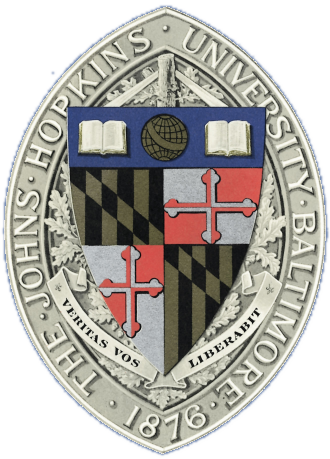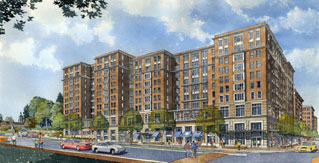General Building Statistics
Building Name: Johns Hopkins University, Charles Commons
Location & Site: Charles Commons is a new dormitory complex for JHU which is located at the corner of 33rd Street and St. Paul Avenue in Baltimore, Maryland. The dormitory is centrally located on campus because its full-service dining hall and bookstore will be used by the whole of the student body.
Building Occupant Name: Johns Hopkins University
Occupancy or Function Types: The new dormitories features a full-service dining hall, a bookstore, and a credit union. In addition, Charles Commons includes various offices, faculty apartments, computer rooms, fitness centers, and loading docks. The use groups are characterized as A-2 and A-3 Assembly, Mercantile, R-2 Residential, and Business.
Size: The Charles building is 12 stories tall and 110,000 sf. The St. Paul building is 10 stories and 203,000 sf. Overall, Charles Commons provides 620 beds and 210 rooms for Johns Hopkins University students. The Charles building is 12 stories and the St. Paul building is 10 stories.
Project Team:
Owner – Johns Hopkins University, Baltimore, MD (www.jhu.edu)
Developer - Collegetown Development Alliance, LLC (Joint Venture between Struever Brothers, Eccles, and Rouse and Johns Hopkins University)
Developer Consultant - Capstone Development, Birmingham, Ala.
Management Consultant - Heery International, Atlanta, Ga.
General Contractor – Struever Brothers, Eccles, and Rouse, Baltimore, MD (www.sber.com)
Architect – Design Collective, Baltimore, MD (www.designcollective.com)
Landscape Architect - Mahan Rykiel Associates, Inc, Baltimore, MD
Foodservice Design - Ricca Newmark Design, Potomac, MD
Structural Engineer - Hope Furrer Associates, Inc, Towson, MD
Civil Engineer – Rummel, Klepper & Kahl, LLP, Baltimore, MD
Geotechnical Engineer - Schnabel Engineering, Baltimore, MD
MEP Engineer – Burdette, Koehler, Murphy & Associates, Inc, Baltimore, MD (www.bkma.com)
Telecommunications Design - Unlimited System Support, Inc, Pikesville, MD (www.ussinet.com)
Acoustical Engineer - Cerami & Associates, Inc, Washington, DC
Dates of Construction: The project started foundations on November 16, 2004 (at the conclusion of demolition). The projected date of substantial completion is June 8, 2006, wherein final completion is August 8, 2006. The University wants the building to be complete in time for the start of the fall session of classes in 2006.
Cost Information: The project is budgeted to cost $57,996,484 in direct costs, $3,302,516 (5.24%) in general conditions, and $1,701,000 in fee (2.70%). The GMP contract total is $63,000,000.
Project Delivery Method: Design-Bid-Build, CM at Risk
Building System Information
Architecture: Two buildings at ten and twelve stories tower over the campus streetscape of Johns Hopkins University. The ten story St. Paul building is U-shaped after the third floor to allow for a courtyard view for the housed students. The Charles building has a rectangular footprint that is continuous on all twelve floors. Both buildings have a variety of room layouts including housing units that have their own kitchen, living, and bathroom amenities.
In addition to student housing, Charles Commons features the following for their students: retail, lounges, computer labs, fitness centers, community kitchens, music rooms, a bookstore, and a full-service dining commons. In order to operate the two buildings, Johns Hopkins will also utilize the following: loading docks, laundry amenities, security offices, mail distribution center, housing and counseling offices, and faculty apartments. The exterior of both buildings are broken up into an architectural precast concrete façade for the first two floors and brick façade for the floors above. The roof for each building is flat and highlighted by a precast cornice.
Main access for both buildings are along 33rd Street and secondary entrances can be found on St. Paul and Charles Streets. The loading area for St. Paul's dining commons and bookstore is found in an alley to the North. Lovegrove Street runs between St. Paul and Charles buildings and serves as access to the North alley loading area and utility access.
Major National Model Code: Charles Commons is being built according to IBC 2000, Fair Housing Act, and American Disabilities Act.
Zoning & Historical Information: Zoning was changed from residential/retail to university housing/retail as part of a developer's agreement. In addition, the existing three and five story buildings were deemed “not historic” and were not under any historic buildings registry. However, the local Charles Street Historic Alliance has a significant role in the height and façade requirements.
Building Envelope: The first two floors of St. Paul and Charles buildings feature architectural precast panels, aluminum curtain walls supporting storefront windows, and canopies framed with aluminum and glass. The other floors have multiple precast concrete cornices, a brick facing, and traditional windows. The walls are framed with 6” metal studs and insulated with 6” R19 batting. The penthouse is covered with overlapping metal wall panels and the roof surface is a non-reinforced EPDM membrane mechanically-fastened with turnbars.
Structural: The foundation system is made up of 3' to 7' diameter reinforced concrete drilled caissons and a mesh of reinforced concrete grade beams. Reinforced concrete columns (varying in strengths from 4000 to 8000 psi) and shear walls tie the foundation into the post-tensioned concrete floor slabs. Structural steel is used to frame the penthouses and bridge between the buildings.
Mechanical: The majority of Charles Commons is served by eight air handling units using chilled water from two 600-ton water-cooled chillers. Ten split-system air conditioning units are used in the Information Technology and Elevator rooms. In addition, one large cooling tower and two gas-fired boilers can be found on the roof of St. Paul building.
For water distribution, one hot water generator, one hot water recirculator, and two hot water heaters serve the Charles building. In the St. Paul building, three hot water heaters are used with one hot water generator and one hot water recirculator. In order to circulate fluids to the roof from the basement, a gas booster and two water boosters have been utilized.
Fire Protection: The fire suppression system is standard wet pipe with standpipes located throughout the complex. Two fire pumps supply water to the high floors of St. Paul and Charles buildings. An automatic sprinkler system is triggered by an automatic fire detection system and emergency voice alarms. The trigger signals are detected by a fire command center which starts the stand-by power system. All exterior walls are 1-hour fire-rated and some interior walls are 2 and 3-hour fire-rated. The buildings are not required to have emergency escapes and smoke controls per the Baltimore City Fire Codes.
Electrical: Two transformers are located in enclosed areas under the St. Paul building. These feed three 480Y/277V, 3?, 4W switchgears rated at 2000A, 2400A, and 3000A, which in turn feed both buildings in Charles Commons. The lighting used in both buildings are recessed fluorescents, pendent fluorescents, and metal halide track lighting.
Telecommunication: Raceways for telecommunications cabling will be located throughout the building, which arrive to each building via Lovegrove Street. The assembly room and computer rooms feature state-of-the-art audio and visual equipment. In addition, fourteen telecom server racks are located in various locations of both buildings to provide fast internet service for JHU students.
Transportation: A pedestrian bridge crosses Lovegrove Street at the third level of both buildings to facilitate use of the dining commons in St. Paul building by students housed in Charles building. In the Charles building, there are two fire-rated stairs and three elevators. In the St. Paul building, there are two fire-rated stairways and six elevators. In addition, there is a curvilinear feature staircase in the St. Paul building that links the main entrance with the bookstore and the dining commons.


